
From Texas to Maine, we checked in with alumni in the path of eclipse totality to hear their preparations and plans.
Some know exactly where they’ll be on Monday, April 8. In Texas, Audrey Cook Bines ’92 and Joel Bines ’92 will be in Ennis for a barbecue eclipse party.
Some don’t know. Pending the latest weather forecast, Michael Lieber ’92 — who vowed seven years ago not to miss this eclipse — is still deciding between Texas, Indiana, or Maine for the best chance for clear-sky view.
Sandra Shea ’75 will be in Carbondale, Ill., which will experience its second eclipse since 2017.
In northern Maine, Eric Stirling ’97 and his children will become the second and third generations of his family to witness an eclipse at West Branch Pond Camps. And all the way across the continent, off the coast of Mexico, Joanna Parkin Bickford ’68 just might be the first alum to see the eclipse: She is on the cruise ship MS Zaandam, off the coast of Mazatlan, Mexico.
Read on!
Audrey Cook Bines ’92 and Joel Bines ’92
- Location: Ennis, Texas
- Totality begins: 1:31 p.m. CST
- Duration of totality: 4:24
When in Texas, do as the Texans do. In that spirit, Audrey Cook Bines ’92 and Joel Bines ’92, who live in Dallas, are heading to Ennis, about 36 miles away, for an eclipse party featuring, of course, barbecue. “It’s Texas!” says Audrey.
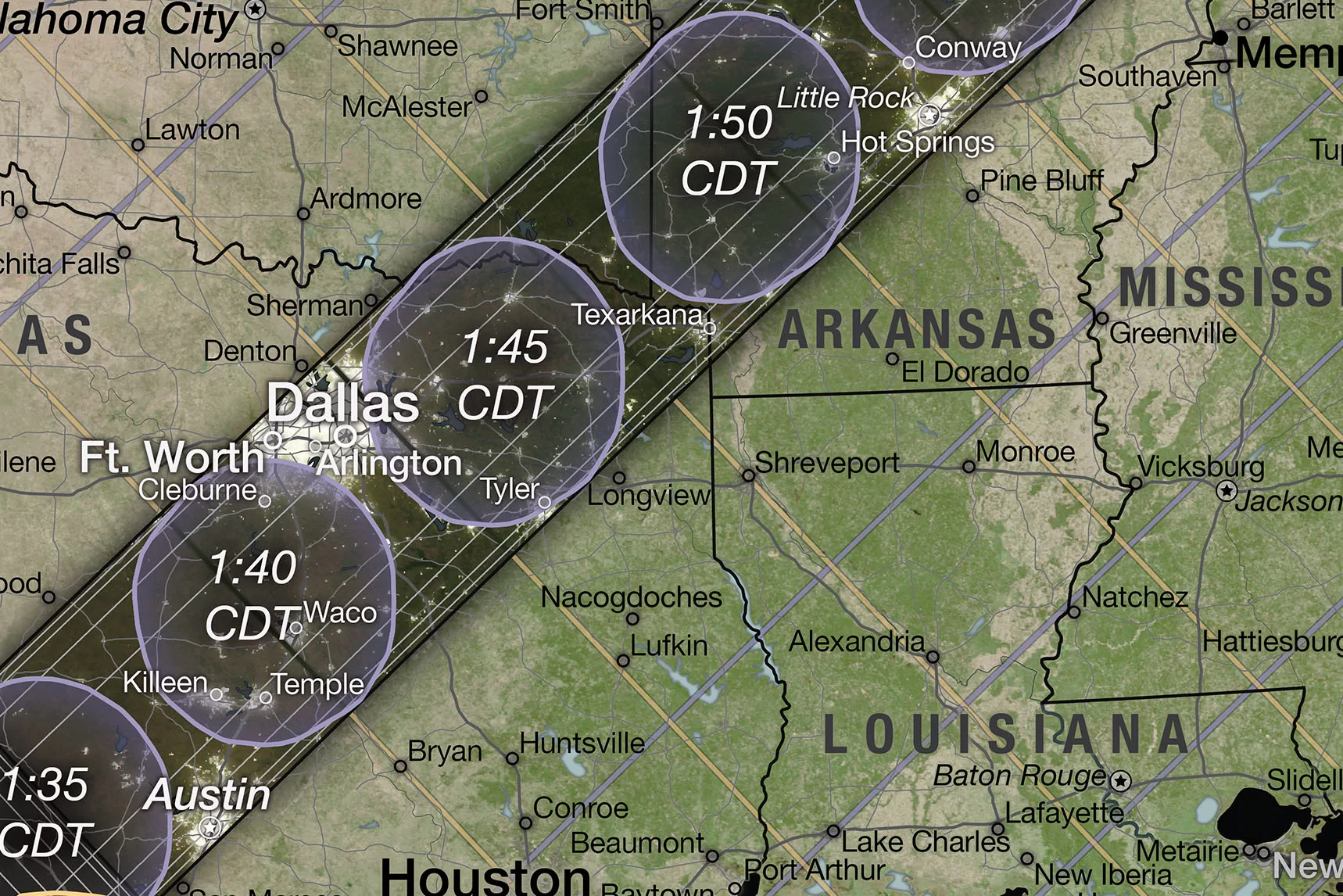
“Innis is directly on the centerline, so it will experience a longer duration of totality than others,” said Audrey, who was born and grew up in Dallas.
The last total solar eclipse in Texas was in 1878, and after this year’s eclipse, there won’t be another until 2045. “So we figured this was truly a once-in-a-lifetime invite to say ‘yes’ to,” she says.
Audrey remembers the partial eclipse on Oct. 3, 1986. “I was in elementary school, and I found it somewhat underwhelming.” No wonder, since only 20 percent of the sun was covered by the moon that time around.
“I don’t think I had the appreciation for the science and the uniqueness of these occasions at that time. Now, I’m curious and looking forward to adding it to my experiences and memories.”
Michael Lieber ’92
- Location: Somewhere
After the 2017 eclipse, which Michael Lieber ’92, who lives in Wilmette, Ill., and works in Chicago, was not able to experience in person, he skipped ahead in his calendar seven years and marked April 8, 2024.
But just where he’ll be on Monday is still up in the air.
“I’ve had a refundable flight to San Antonio for a year,” he said on Tuesday. But the forecast there is iffy, so he pivoted to a “perfect spot in Indiana.” But with clouds possible there, too, he has since booked another refundable flight, to Boston. From there, he could make a bee-line to northern Maine.
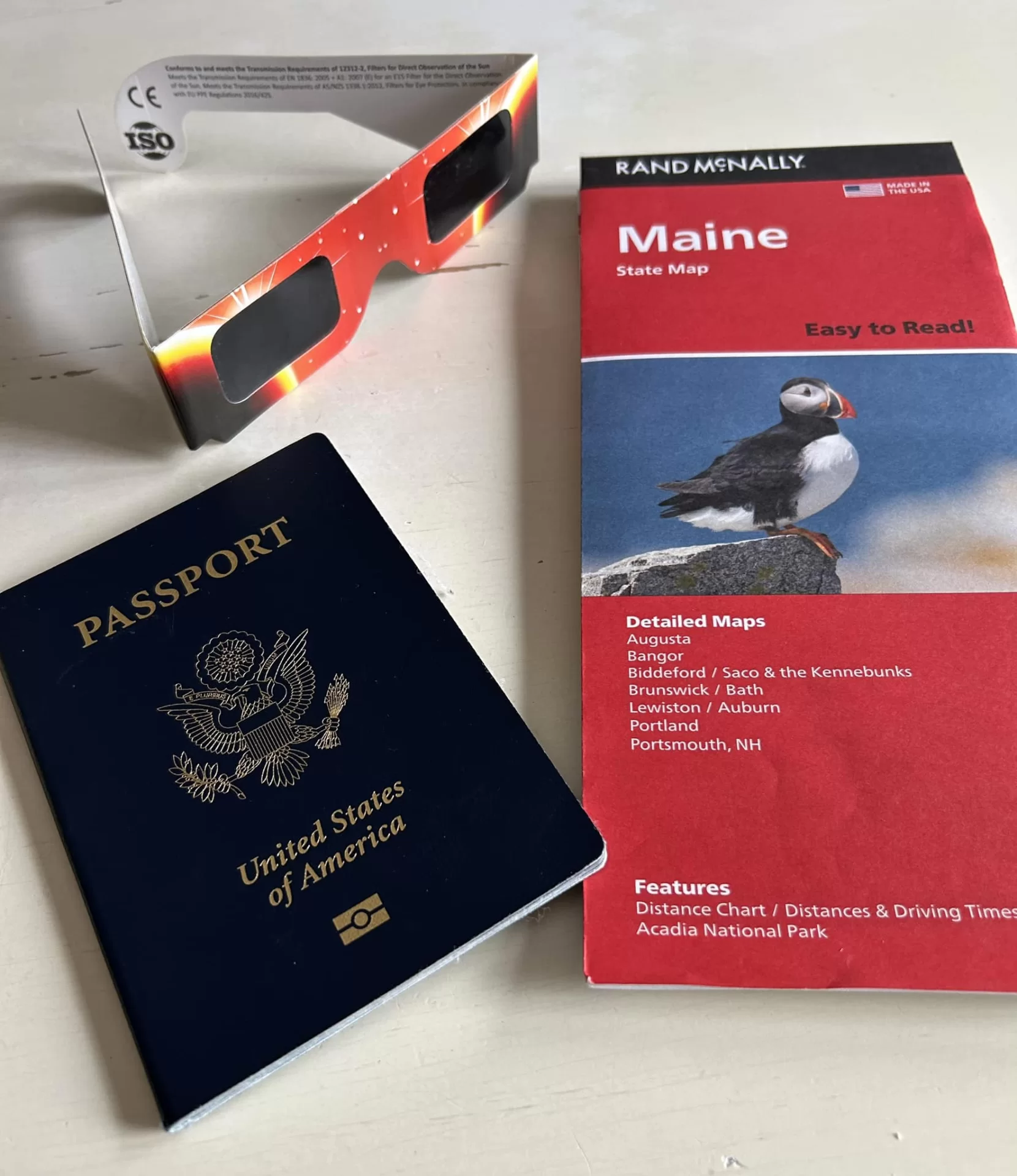
He’ll make his final call on Saturday. For now, he’s booked a hotel room in Auburn. From there, he plans to grab some grub from Forage on Lisbon Street in the morning, pick up his Bates daughter, Sarah ’26, and then drive north.
Sandra Shea ’75
- Location: Carbondale, Ill.
- Totality begins: 1:59 p.m. CST
- Length of totality: 4:10
Without ever leaving home, Sandra Shea ’75 is in the path of a total eclipse for the second time in seven years.
In 2017, when Carbondale and Shea experienced the eclipse, she noted that “everything about the eclipse is interesting. I’m a nerd, I admit it.” Retired from a faculty career at Southern Illinois University, she taught psychology and neuroscience at the School of Medicine, so “science is everywhere, every day.”
This time, Shea plans to watch it in a rural area about five miles across town. She’ll be in the yard of a friend who is a member of a number of astronomy groups. The gathering will be a barbecue-turned-viewing spot with an array of telescopes set up.
Hotels in the area have been booked for years, Shea said. Carbondale, which has a population of roughly 20,000, and the Southern Illinois University campus, which has another 12,000, will see an influx of an estimated 40,000 visitors this weekend.
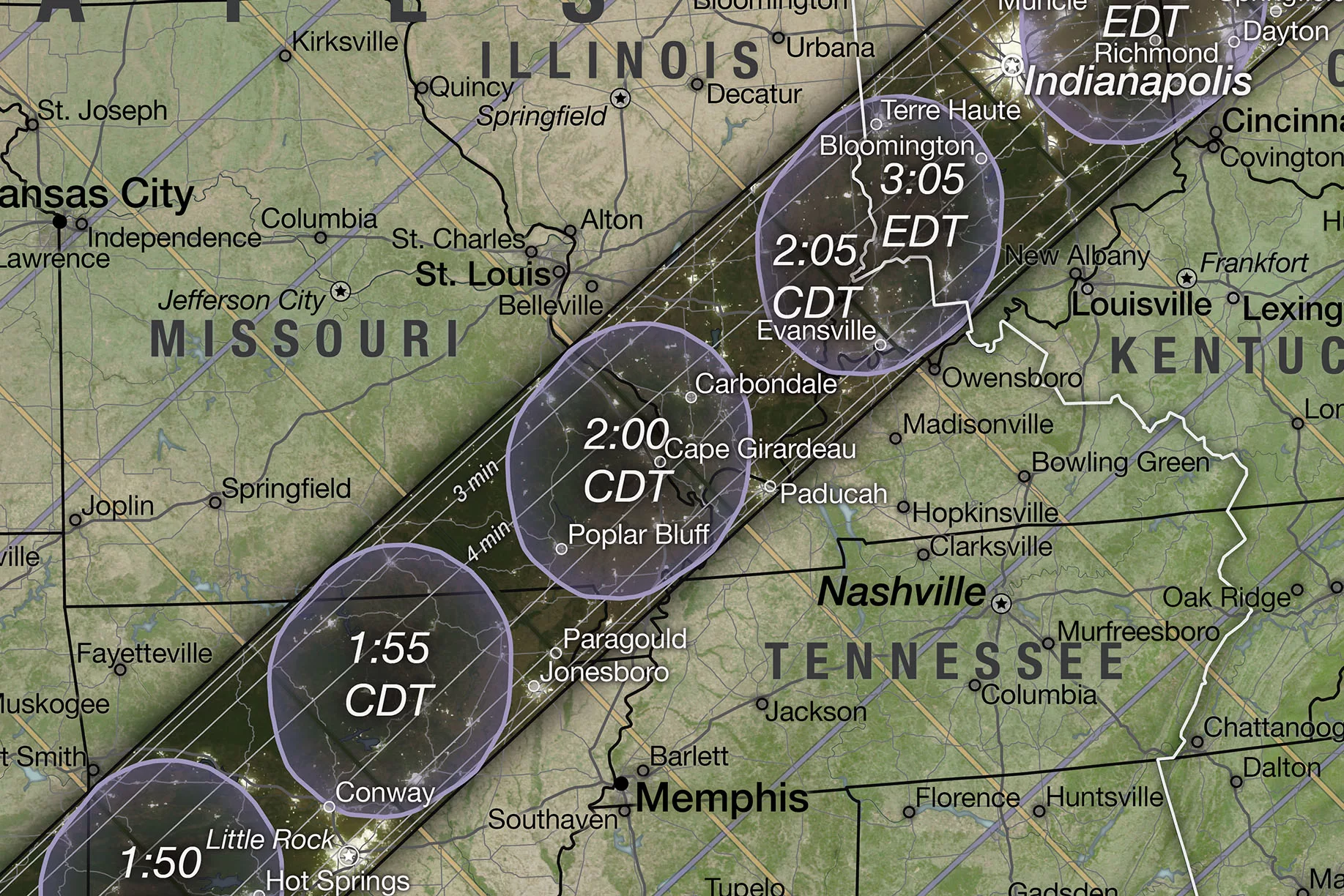
“I think it’s a lot of fun that it’s happening again. As the local media says, it’s a once-in-a-lifetime — and here is the second one,” Shea said laughing.
As for the all-important weather forecast, she says “it’s odd for it to be sunny in early April. Right now, though, the forecast is holding.”
What she recalls most from the 2017 eclipse was how it got so cold, so fast. “It’s amazing how fast it cools off. It’s a very unusual feeling. If you didn’t know what was going on, you’d be perplexed.”
This time around, totality is longer, more than 4 minutes. “We’ll get to hear birds coming back to their nests, and the crickets come out. Birds apparently are quite sensitive to this. They don’t know why it’s night suddenly.”
— by Deirdre Stires
Jane Goodman ’78
- Location: Bloomington, Ind.
- Totality begins: 3:06 EDT
- Duration of totality: 4:04
Jane Goodman ’78, a professor of anthropology at Indiana University, has an ideal post-eclipse event to go along with being in the path of totality in Bloomington.
Joined by her sister and brother-in-law who will be visiting from Cape Cod, she will watch a documentary about Star Trek‘s William Shatner, William Shatner: You Can Call Me Bill, at the Indiana University Cinema — in the presence of Commander Kirk himself.
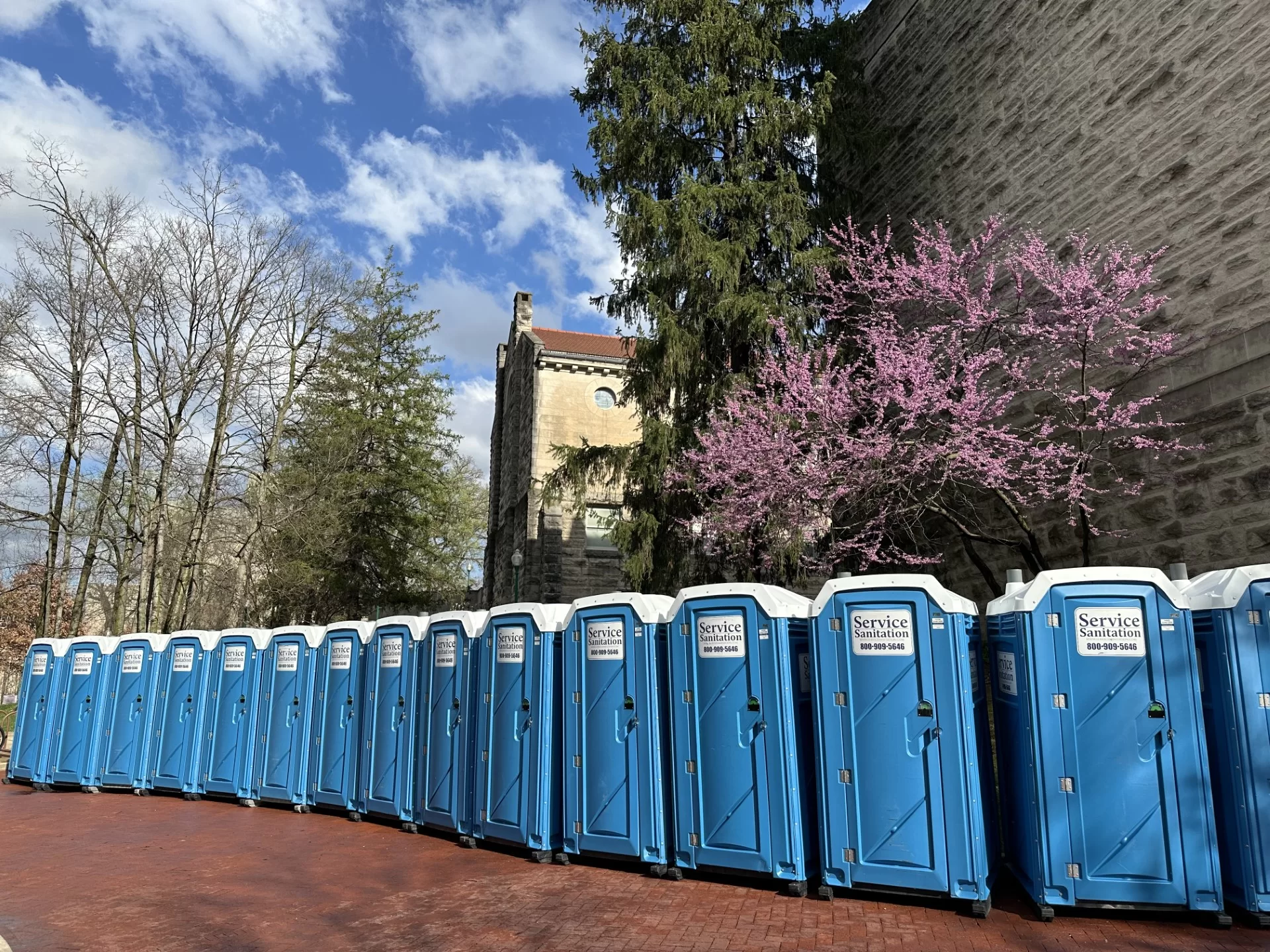
“We’re also on a list to potentially meet Shatner in person. My brother-in-law is a big Star Trek fan, so this will be fun,” she said.
Indiana University is a huge school with more than 45,000 students, and in such a packed place, there’s lots of pre-eclipse talk about the crowds that will accompany Monday’s 4-minute totality.
“I’d say that the vibe in Bloomington is mixed,” said Goodman. “A mix of anticipation and anxiety about what it will be like to have what’s being talked about as the equivalent of five football games happening in town simultaneously.“ (Indiana football games can draw more than 50,000 fans to Memorial Stadium.)
“Some people just want to hunker down and stay away from the impending crowds. There’s talk of an impending traffic nightmare. Pictures circulate on social media of the nightmarish traffic leaving Kentucky after the 2017 eclipse there.”
Like so many others in the path of totality, Goodman is “trying not to obsessively check the weather for that day.”
Caty Green ’11
- Location: Indianapolis, Ind.
- Totality begins: 3:06 EDT
- Duration of totality: 3:47
As a journalist who grew up in Indianapolis, Caty Green ’11 has a sense about events like this. “There’s a good portion of the population that can’t fathom the number of people that’ll be flooding in along the path of totality,” she says.
So, she will take the day off from work and “plans to enjoy the eclipse with my dogs in the backyard. I considered meeting up with my family, but traffic around Indianapolis is expected to be a nightmare, so staying put seemed like a good plan.”
Green’s current work is in audience development as newsletter editor at Civic News Company, the parent organization for Chalkbeat and Votebeat, two nonprofit newsrooms covering public education and election administration, respectively.
During the 2017 eclipse, when she was with The Atlantic, Green road-tripped from D.C. with a colleague to view it. After weather-related detours, “we ended up at a Tennessee state park in a field with I’d guess a few hundred people.”
She says she’ll “never forget the shift in the natural soundscape around us as this artificial night took over. We both wrote about it for The Atlantic, though my angle was far less serious than a science writer’s: ‘The Procrastinator’s Guide to Cosmic Marvel.'”
Noah Petro ’01
- Location: Cleveland, Ohio
- Totality begins: 3:14 p.m. EDT
- Duration of totality: 3:49
In 2017, when the eclipse began its totality in Oregon, NASA scientist and baseball fan Noah Petro ’01 was representing the space agency at a minor league baseball game that had the first eclipse delay in professional baseball history.
This time around, he and his family (wife Jen Giblin ‘01 and their three children) will be in Cleveland helping to represent NASA at the Glenn Research Center, which is hosting a weekend-long event. (NASA has a full set of eclipse resources, including maps and visualizations used in this story.)
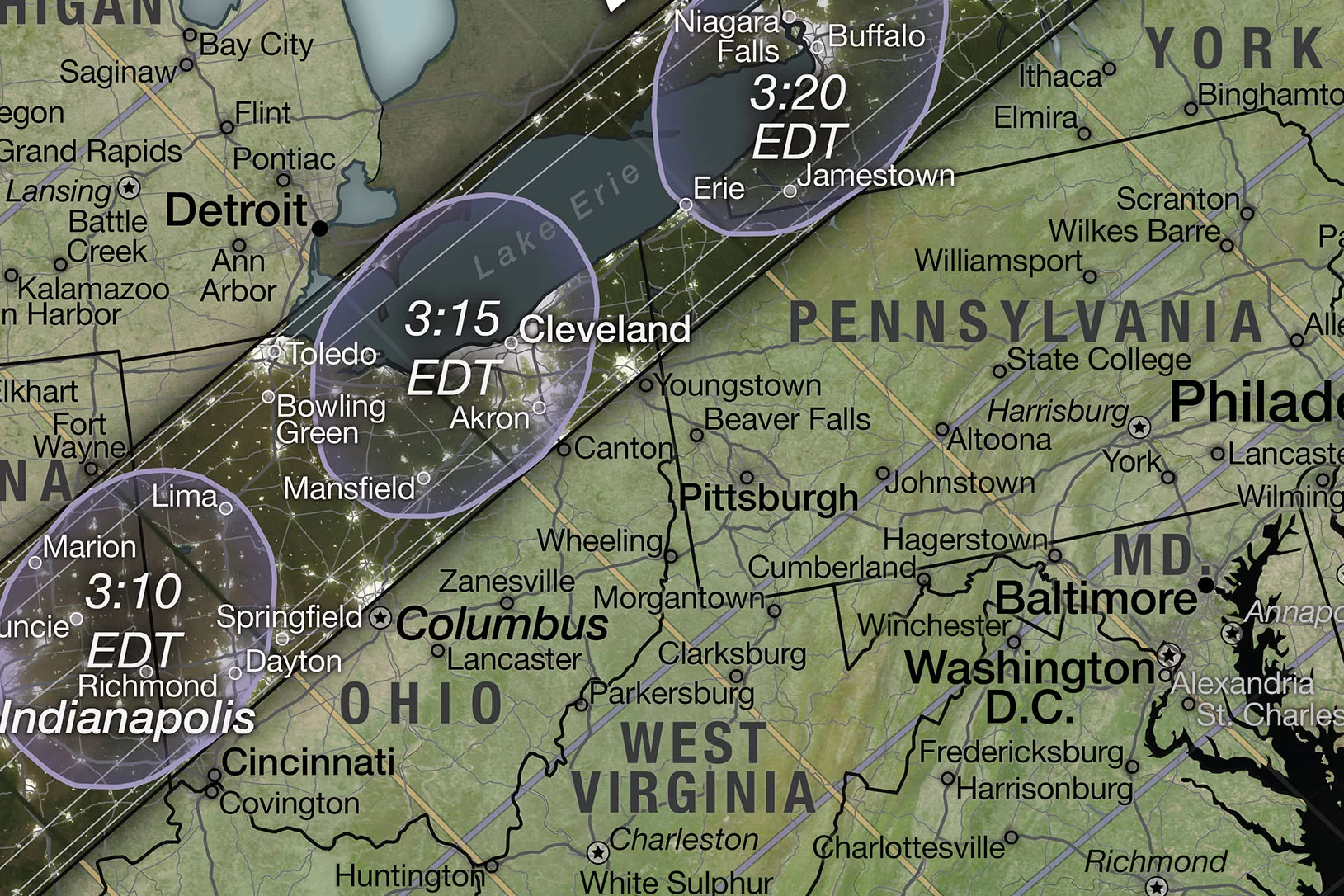
During the eclipse itself, “our plan is to watch the eclipse with classmate Erin Mullin Shank ‘01 and her sons. We’ll try to find a spot to watch with them away from the big crowds expected in downtown Cleveland, which is also hosting the Women’s NCAA Tournament this weekend!”
The moon is literally Petro’s job. He’s the project scientist for the Lunar Reconnaissance Orbiter, currently circling the Moon, and his next gig is as the project scientist for Artemis III, humanity’s first visit to the Moon in more than half a century.
“I’m thrilled that this object that I study and care so passionately about has its moment in the sun, as it were!”
From a professional perspective, Petro is interested in the role the Moon plays in causing the eclipse, “and how the shape of the Moon defines the path of totality, which is not a sphere, but is more irregularly shaped due to the shape of the Moon.”
This time around, the path of totality is better known, thanks to the Lunar Reconnaissance Orbiter, which has produced images with high-resolution topography. “We can predict where the eclipse will fall on the Earth with great accuracy.”
And personally, Petro is excited by the eclipse “as a sensory and cultural event. Not only do you see an amazing site, but you also feel the temperature drop, you see shadows change, and you hear animals do their nighttime routine. Being in the path of totality is an immersive experience!”
Kelly Andrew ’96
Location: Chazy, N.Y.
Totality begins: 3:26 p.m. EDT
Duration of totality: 3:36
In Chazy, N.Y., lots of traffic warning signs are everywhere, says Kelly Andrew ’96. “Which makes me chuckle when we don’t even have a streetlight.”
Andrew is the grower house manager for Giroux Poultry in Chazy, a fourth-generation family farm, a few miles north of Plattsburgh. “My glasses are purchased, and I have my spot on the farm picked out, on a hill that leads to open fields so there shouldn’t be any obstruction.”
After being buffeted by a recent winter storm, grocery shelves are getting bare. “We aren’t sure if our grocery shelves are empty due to the storm, spring break, or people just shopping early to avoid crowds this weekend.”
She will be working when totality arrives, and like others who work in agriculture or with animals (read on!), she will also keep her attention on the birds.
“We expect some of our birds to exhibit normal night time behaviors by quieting down and looking for and heading to their roosting spots. Once the eclipse has passed, we assume the birds will go back to their normal daytime behaviors. We will certainly be assuring safety and well-being.”
Hannah Sessions ’99 and Greg Bernhardt ’99
- Location: Leicester, Vt.
- Totality begins: 3:27 EDT (in nearby Middlebury)
- Duration of totality: 0:45 (in Middlebury)
Hannah Sessions ’99 and Greg Bernhardt ’99 operate an AirBnB on their goat dairy and cheese-making farm, and last summer someone booked the weekend of April 8, 2024.
“That’s odd,” Sessions recalls thinking. “Booking a random weekend in April that far in advance?” In Vermont, early April is a slow time — skiing is mostly over, it’s mud season, and warm-weather activities aren’t possible yet. “Well, the joke was on us! Those folks were smart — there is no room available anywhere in Vermont now.”
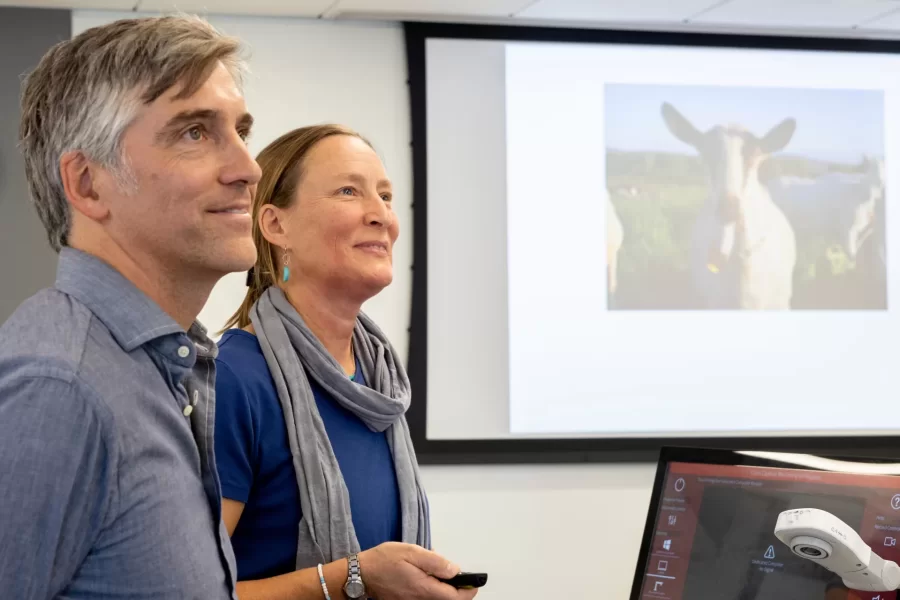
Vermont is bracing for crowds that some say might rival the throngs that crowded into the state for Phish’s farewell concert in 2004 and brought traffic on Interstate 91 to a halt. “They expect north of 200,000 visitors to the northern part of the state — the entire population of Vermont is around 600,000, so that’s quite a jump,” said Sessions.
Their farming operation, Blue Ledge Farm, is in Salisbury, just outside totality, so the couple plans to drive the eight miles to nearby Middlebury to experience a few seconds of darkness, then scoot back home.
“There has been concern about how animals will react to this event,” she explained. “As farmers, our first concern is with our animals, so our plan is to not travel more than the 10 minutes it takes to get into the path of totality. No crazy eclipse party for us until we know all is well with the goats!”
In addition to operating Blue Ledge Farm, Sessions and Bernhardt are painters.
From her perspective as an artist, Sessions is enchanted knowing that the stars will come out as the sun goes away. “It’s a reminder that the stars are always there. That’s how I see art: it’s purpose is to show us the beauty of simple moments, and remind us that beauty is always there, it’s just hidden sometimes — like the stars.”
Blue Ledge makes a seasonal cheese called “La Luna.” Of course, it’s sold out, but a local co-op food store saved one wheel, which will be sold on Monday only.
“So you see, it is total eclipse mania around here! And we’re crossing our fingers for a clear day.”
Friedrich Buschmann ’71 and Margaret Kendall Buschmann ’72
- Location: Harmony, Maine, just southeast of totality
“I’m tempted to go somewhere and see the whole ring of fire thing,” says Margaret Buschmann ’72, who lives in Harmony. “We’re going to be so close.” She lives right in “the middle of nowhere” with her husband, Fritz Buschmann ’71, whose father was a German professor at Bates.
She says Harmony, north of Skowhegan, is projected to see an eclipse of 99.82 percent, just a smidge away from totality. Two things are stopping her though. First are the anticipated crowds. “They’re saying they’ll have 40,000 people! The traffic will be atrocious.”
The second are her feathered friends. “I want to see how the birds react.” During eclipses, animal responses are legendarily notable — but Buschmann isn’t talking about the cardinals and chickadees at a birdfeeder.
The couple run Siesta Sanctuary, home of 38 (currently, as the numbers change all the time) parrots, macaws, cockatoos, and the like, ranging from age 11 to at least 42. They’re both animal lovers, and Margaret has thought parrots are “the coolest thing on the planet” since her parents took her to Busch Gardens in 1956 and she saw her first parrots.
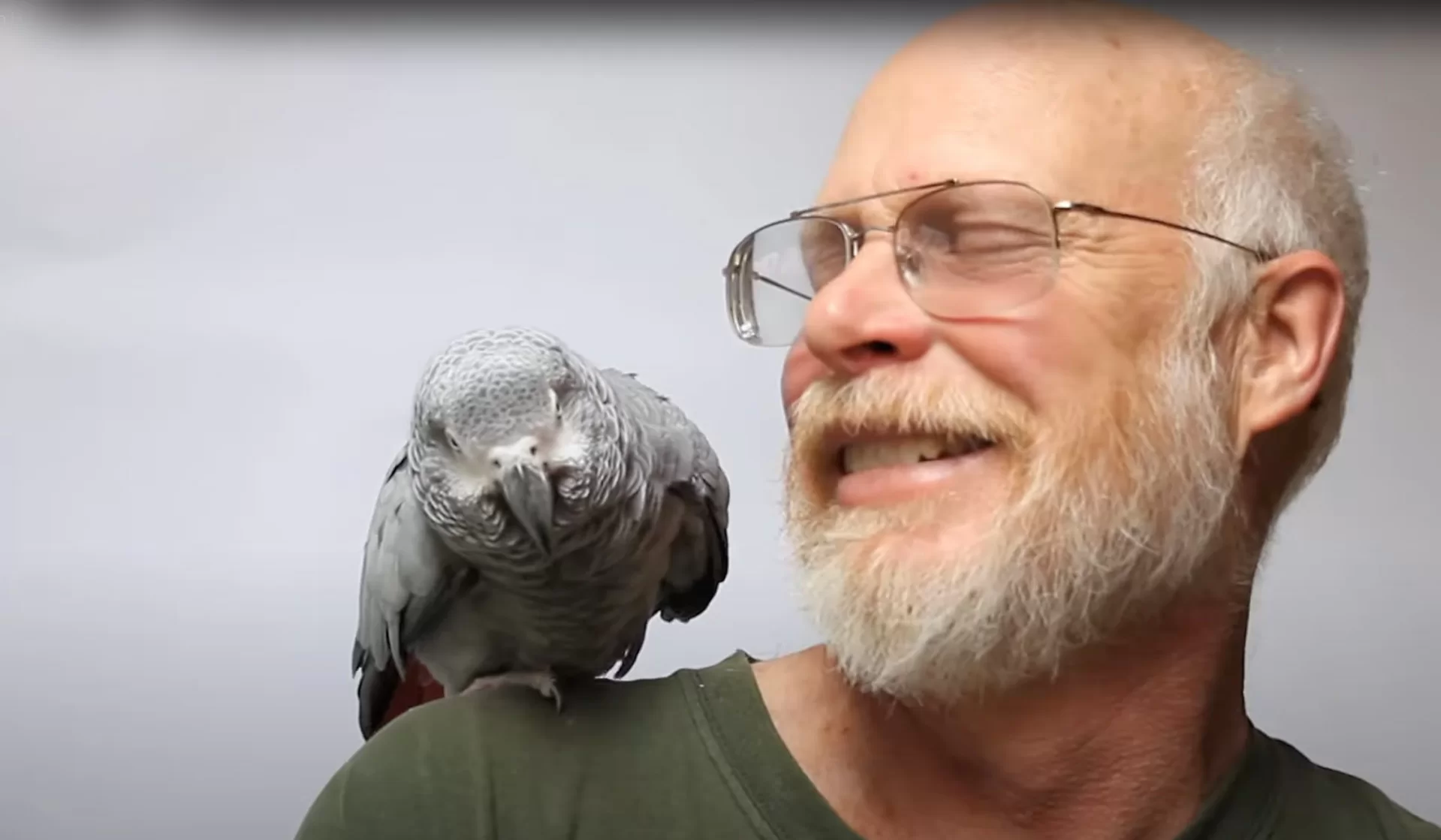
In Harmony, they’ve got a flight room and “cages stacked on cages” providing temporary homes for birds whose owners have died or gone into assisted living, or who just get in over their heads with what they think is going to be a fine pet bird and need to surrender them.
The couple started their bird journey as empty nesters in Harmony, with plans to raise some baby parrots, but the operation steadily grew into a full-blown sanctuary. These birds, with their intellectual capabilities akin to a 5-year-old human, are not for everyone, she says.
“This is not like having pets,” Buschmann said. “This is a lifestyle. It’s like taking in a wild cat or a kangaroo. They live by their instincts.”
One of those instincts is when it’s time for bedtime. They require 12 hours of sleep, and usually by 7 p.m. some of the birds announce — very clearly — that it’s time for lights out, like the African gray she’s currently babysitting, who squawks, “Bedtime!” That’s when the couple typically puts covers on the cages and retreat upstairs to do things like watch television. “Which we have to do upstairs. The birds figure if someone is talking then they should talk louder.”
Will the eclipse bring requests for early beddy-byes? That’s what she’s so curious to see. The couple won’t put covers over the bird’s cages. And they’ll probably run in and out of the house during the course of the moon’s movement over the sun.
“I am going to stay right here and see what I see,” Margaret says. “And see what the birds do.”
— by Mary Pols
Eric Stirling ’97
- Location: Township A, Range 12
- Totality begins: 3:30 p.m. EDT
- Duration of totality: 3:03
Eric Stirling ’97 lives with his wife, Mildred, and young children, Avis and Oscar, so deep in the North Maine Woods that GPS doesn’t work, and instead of a warm and fuzzy name for his community, there’s a grid location: Township A, Range 12.
The beauty and peacefulness of their family business, West Branch Pond Camps, is renowned, and he’s looking forward to catching the eclipse there with friends and family. “We decided not to reopen for lodging during the eclipse due to the logistical difficulties of having customers staying here during the height of our mud season,” Stirling says.
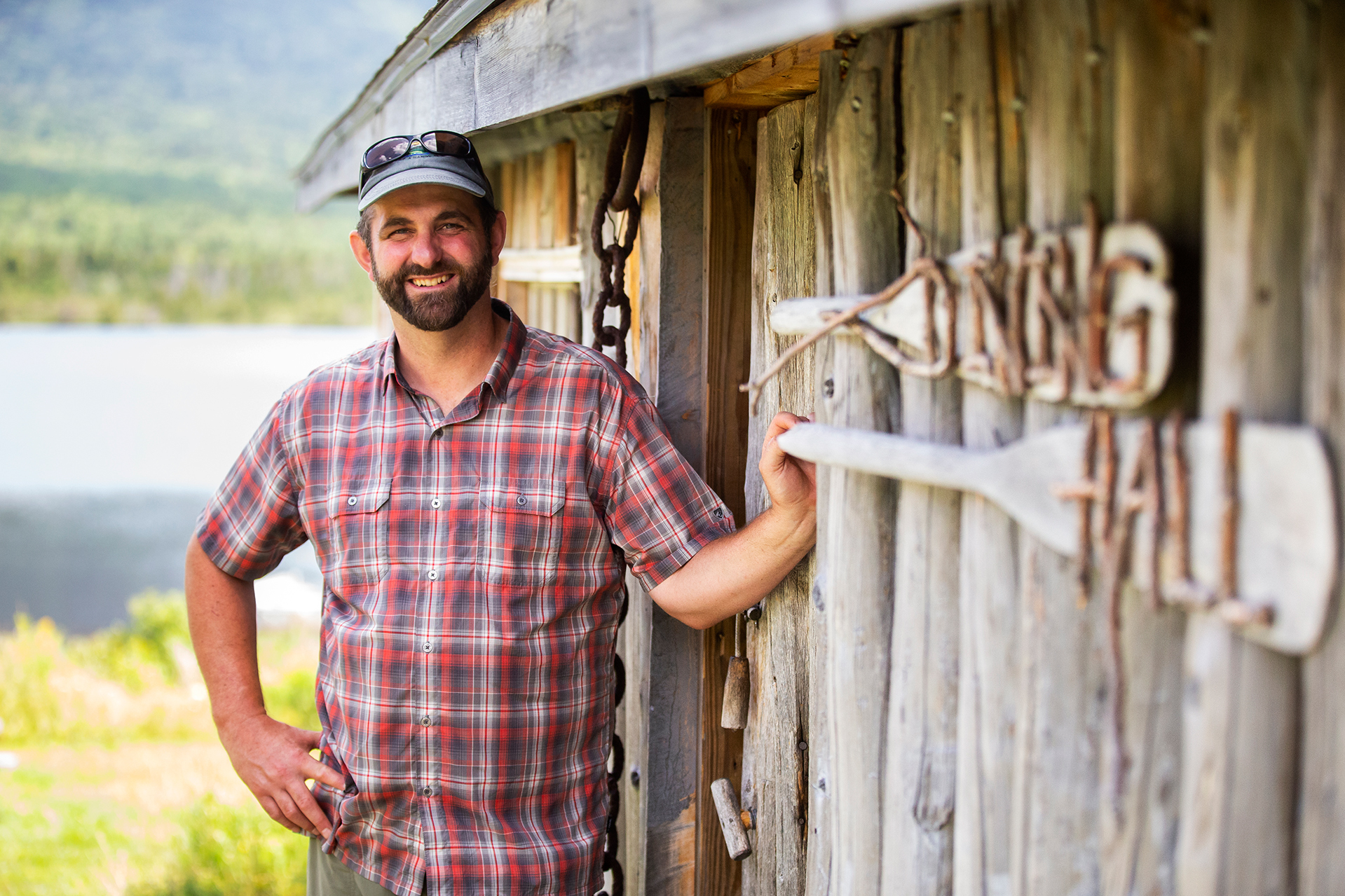
Earlier this week, he pointed out that April 8 represents an uncertain time of the year, weather wise, then updated us right before he headed out Thursday to plow five miles of road — for the second time that day — during the early spring Nor’easter.
“I’ve been amazed by just how many visitors businesses and local authorities are expecting during the eclipse,” he says. “I had no idea that it could generate so much interest.”
Their plan for Monday is to boil sap from their trees, a ritual spring activity, while watching the eclipse. He’ll be using his digital camera to capture images of the woods and open areas during the eclipse. “I’m most excited to see the colors and shadows that are so unique to a total eclipse.”
West Branch Pond Camps has been in the Sterling family for six generations. This year’s eclipse marks the third generation (at least) to see an eclipse on the family land.
“My mother was here at the camps as a teenager on July 20, 1963, when there was a total eclipse. She remembers my grandfather borrowing an old army truck from someone and taking the whole camp up onto White Cap Mountain to watch the eclipse from a logging road.
“My children love all things astronomy and are hoping to see stars when the sun is totally eclipsed. They’ve grown up here in the woods under a true dark sky all of their lives. I’m sure that whatever they see and experience during this eclipse will stay with them for the rest of their lives, like it has for my mother.”
— by Mary Pols
Ian Shearer ’91
Location: Millinocket, Maine
Totality begins: 3:31 p.m. EDT
Duration of totality: 2:27
As a volunteer chaplain for the local police force in Millinocket, about 70 miles north of Bangor, Ian Shearer ’91 once used his Bates cross country experience to chase a burglar until the suspect stopped from exhaustion.
As the eclipse heads into northern Maine, Shearer, who is the senior pastor at Faith Baptist Church in Millinocket, doesn’t have to chase totality.
He says that his plan on Monday “is just to go outside and watch the eclipse in an open field near our house with my family,” his wife, Marcie, and five children.
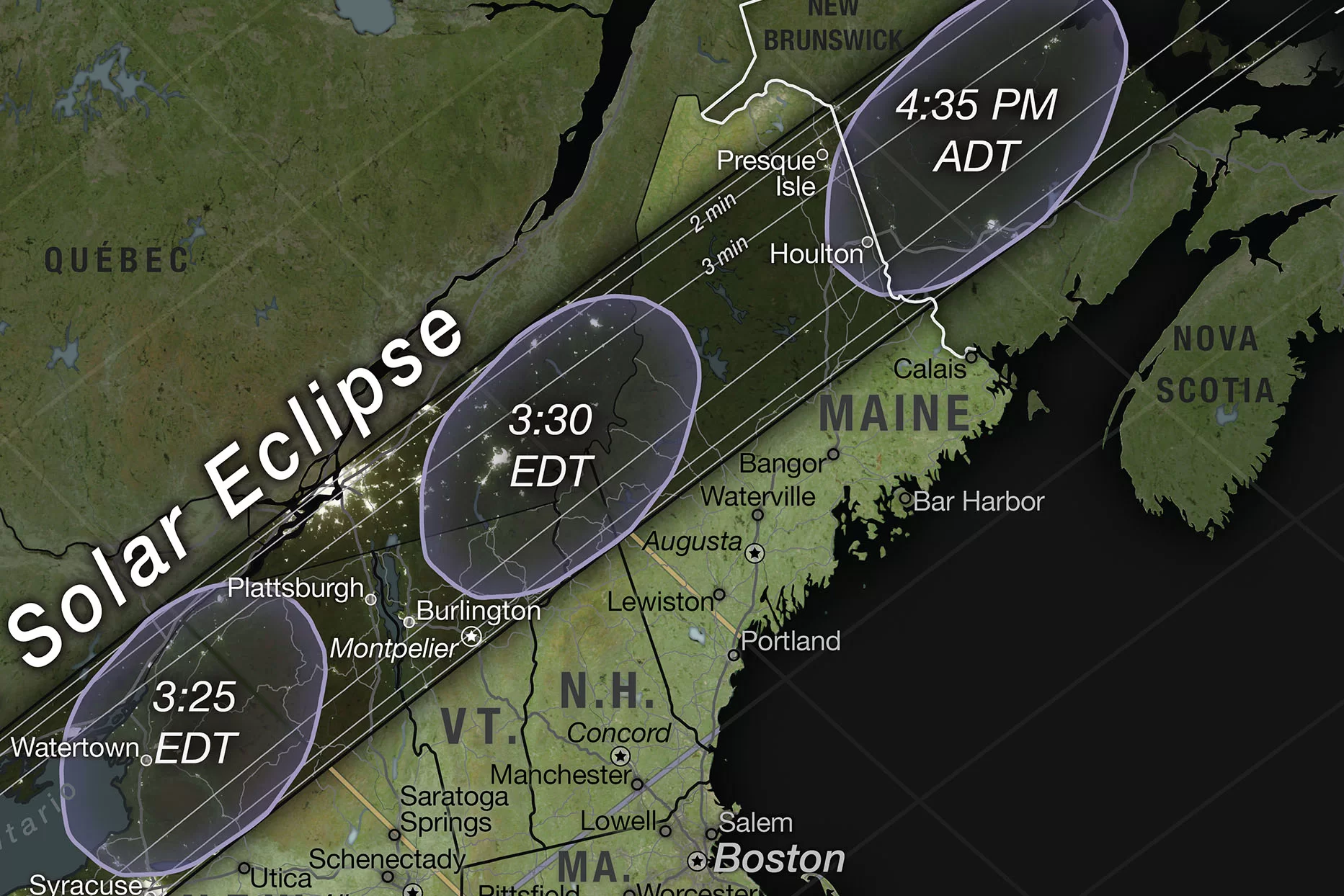
Being far from the maddening crowds means the Shearer hasn’t been swept up in all things eclipse.
“I honestly have not given a lot of thought to the eclipse other than a couple articles in the newspaper.” And that includes his congregation. “No one has asked about the eclipse.”
He knows the event will draw crowds to his town, which has worked to revitalize its downtown following the loss of its paper-making industry in the 2000s. “The thing that has surprised me is how big a deal this is for some people. MIllinocket is a town of about 3,500. They are telling us to expect 10,000 to 40,000 people in town on Monday. I find that a little hard to believe — but we will see.”
Large or small, the crowds will find some parking thanks to Shearer: Visitors are welcome to park in his church parking lot, he says.
Additional reporting by Deirdre Stires and Hannah Kothari ’26



